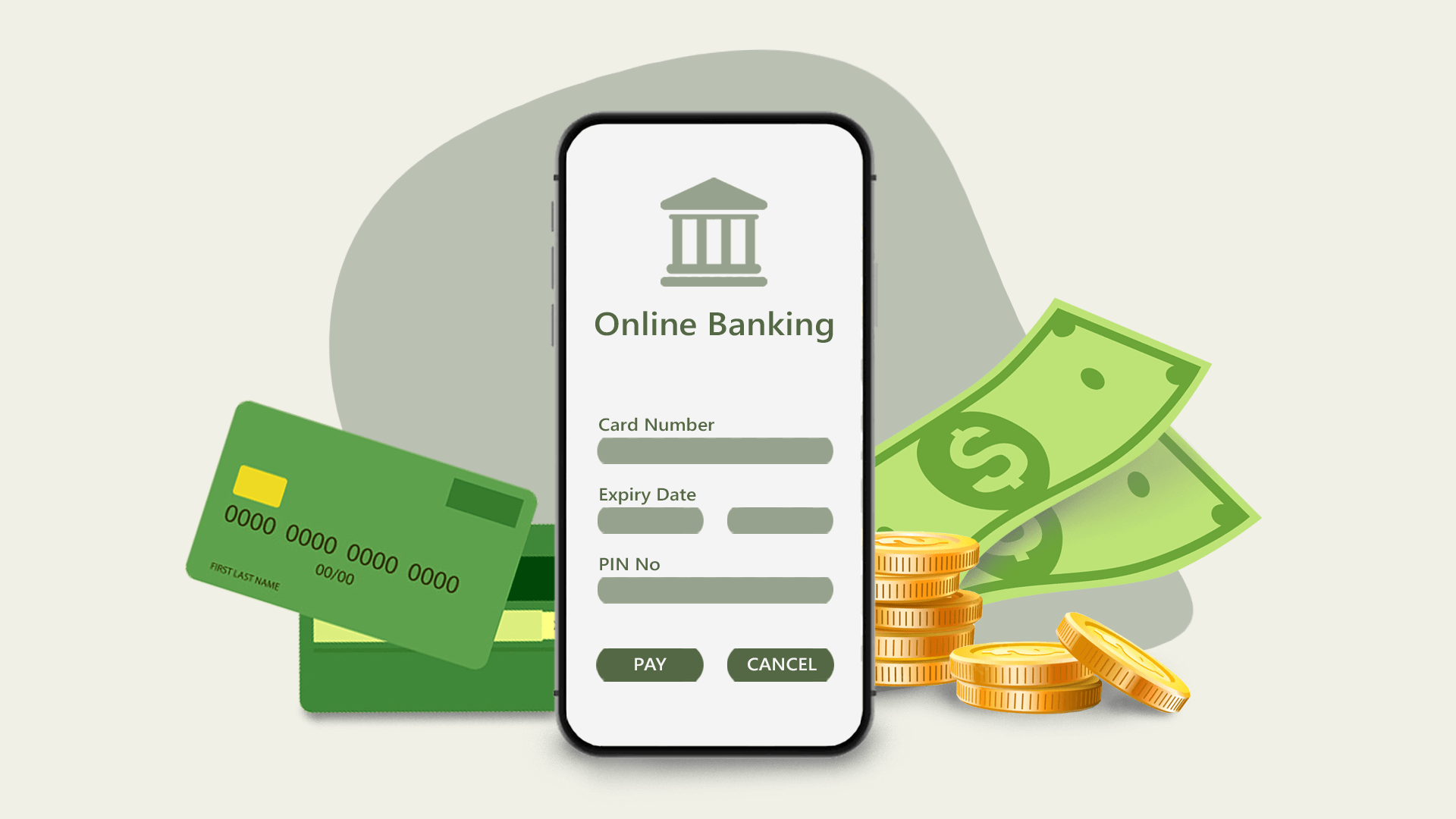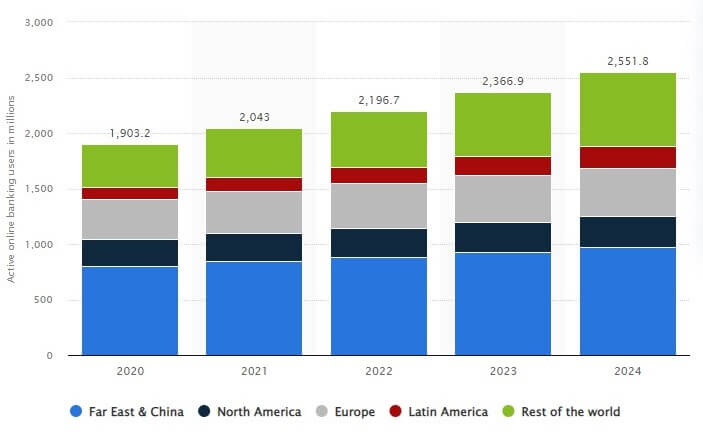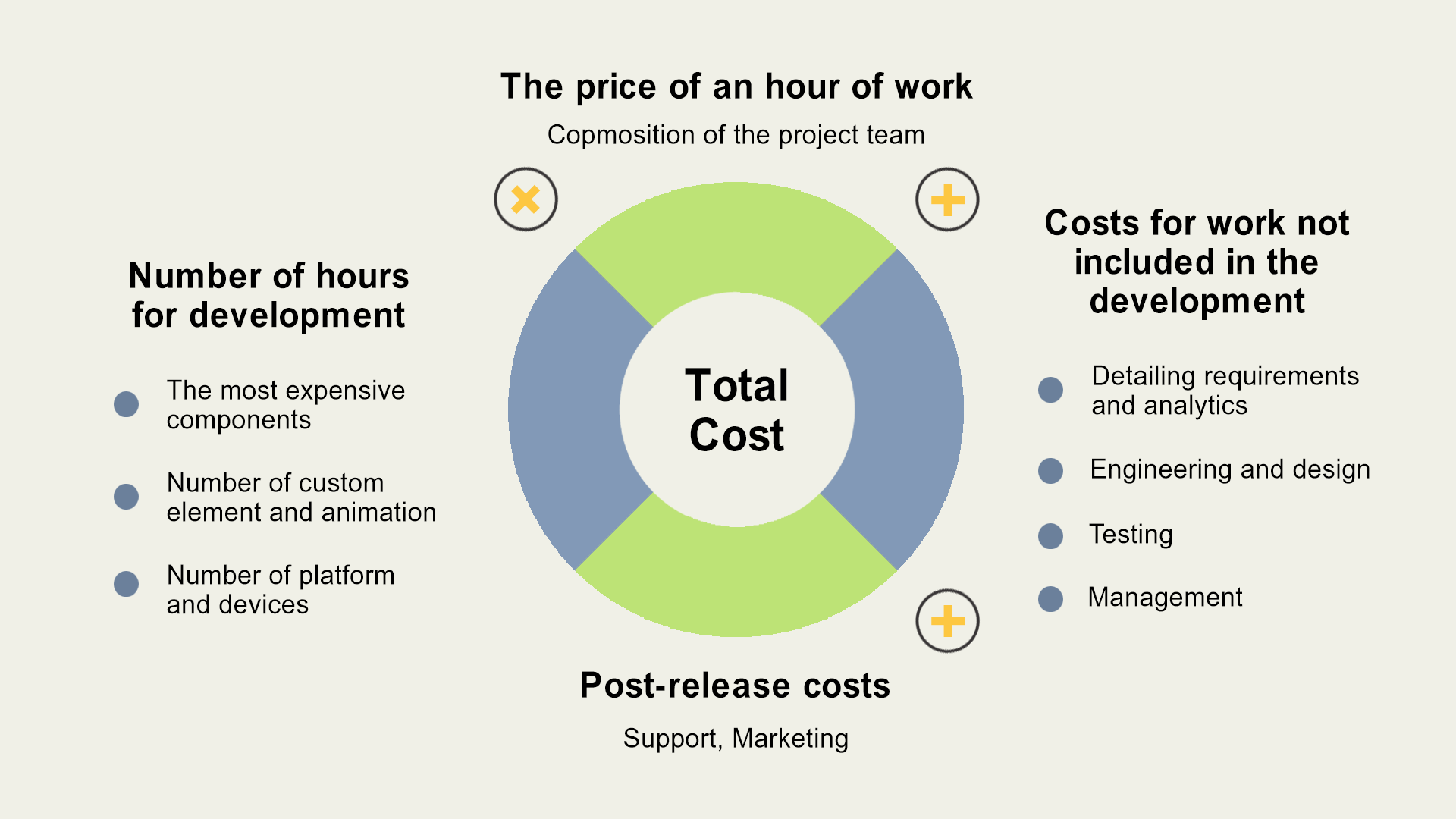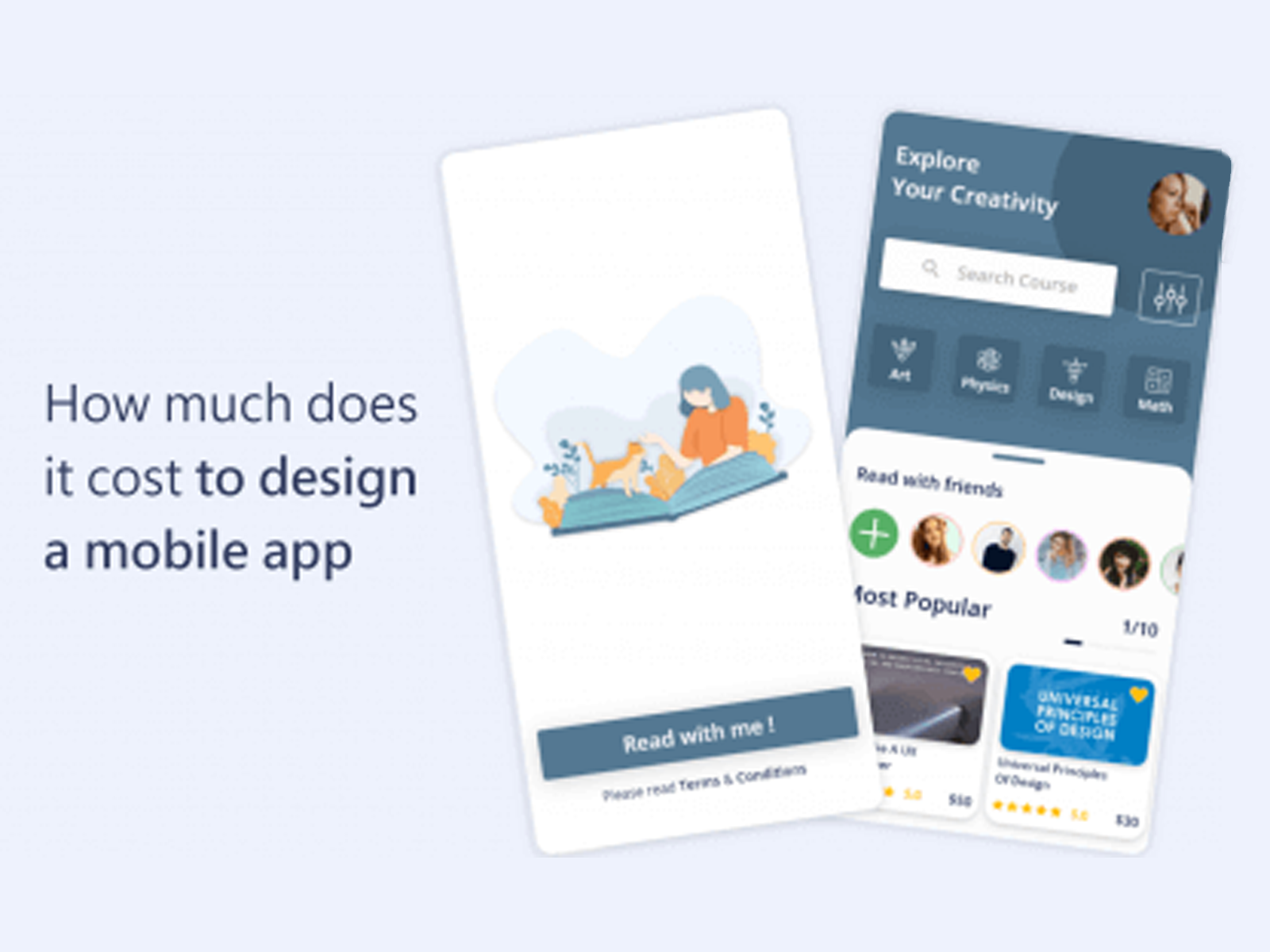How to Create a Banking App: Ultimate Guide from Experts

Do you remember the times when you needed to wait in line at a bank to open an account?
Luckily, the times are far gone.
Now you don’t need to leave your home or even your bed for such tasks. A smartphone and a banking application are all you need.
In 2020, 1.9 billion people worldwide actively used online banking services. The number is projected to reach 3.6 billion by 2024.
Sounds exciting?
Let’s explore how to create a banking application.
Before we move on, take a sneak peek into what’s waiting in the guide:
- Key reasons to create a banking app [benefits for businesses & users]
- Main benefits of mobile banking app development
- How to create a banking app step-by-step
- Banking app development cost
Are you in? Read on.
Why Build a Banking App: Statistics & Benefits
The growth of smartphone users encouraged companies to actively explore the new medium. Even banking organizations couldn’t stay aside and started creating banking apps.
For the past decade, mobile banking has been actively developing and morphing from balance-checking solutions into the whole banks in your pockets.
A banking app is a mobile application where users can access their bank account, complete transactions right from their mobile devices, check balance, view payment history, etc. The main goal of such applications is to provide key banking services right on mobile devices.
Today, three main types of banking apps are identified:
- Mobile banking – a mobile application that provides users with features to control their banking accounts, make payments, get help from 24/7 customer support, and perform other financial operations.
- Client banking – a software for corporate clients that is installed on a PC. It’s not designed for banking on the go, as you always need to have access to your computer or laptop.
- Internet banking – a web application that works in a web browser and requires a stable internet connection. Sometimes, the capabilities of such solutions are wider than of mobile banking applications.
Billions of people all over the world are active users of banking applications.
Bank of America can boast the biggest number of users – 30 million active users of its mobile banking app.
Around 77% of Millenials are ready to switch to digital-only banks in the USA. The number among older generations is a little bit lower – at 66%. Around 95% of Gen Z are already using mobile banking solutions.

Banks without a dedicated mobile application are at the threat of being thrown out of the business in the very near future. Clients love such applications because of the provided convenience and instant access to banking services.
Let’s review some of the benefits that banking apps offer to businesses and users in more detail.
Mobile Banking App Development: Benefits for Users
For millions of people all over the world, mobile banking apps have become the main way to control their finances. Such applications offer a lot of advantages. According to Statista, users use mobile banking applications to
- Quickly view balance
- View recent transactions
- Make bill payments
- Transfer funds
- Contact customer service
- Open a new account
- Reorder check
We can also add a few other benefits of banking applications for users:
- 24/7 access
- Remote deposits
- Best security practices
- Access to the history of transactions and their details
The images below represent a percentage ratio of key reasons to use banking apps among clients in the USA.
Create a Banking App: Benefits of Financial Institutions
There should be a balance between advantages for users and for businesses. It’s not enough to know how to create a banking app. You need to understand what business benefits you want to get.
- Wider Client Base
There is nothing that can stop the growth of mobile banking's popularity. The provided convenience will help you attract more clients and significantly expand the client base.
- Reduced operating expenses
Moving a part of or even all operations online significantly reduces operating costs. You don’t need to open a banking branch or a few in every city where you have clients.
- Enhanced customer loyalty
Clients can access banking services from any location in the world. They can quickly make payments, get 24/7 customer support, check their balance, and much more. All of this combined creates a better customer experience, which results in higher customer loyalty.
- Good Return on Investment (ROI)
Banks save a lot of money when they reduce the number of offices, staff, and branches. Moving online, you can significantly increase ROI and optimize expenses.
- Personalized services
Mobile applications can be powered by Artificial Intelligence and Machine Learning. The information the systems collect can be used to create a highly personalized experience for mobile users. The received information will also help to create users’ behavior models to identify how to create a banking application further.
- New marketing channel
Creation of a mobile application will open up a new marketing channel. You can use the collected information to create special offers, promote other services, and notify customers about any changes in your business.
How to Create A Banking App: Step-by-Step Guide
Banking mobile app development can be broken up into eleven main steps:
- Conduct market research
- Analyze target audience
- Identify and investigate competitors
- Find a development vendor
- Choose basic features
- Choose advanced features
- Address the challenges of mobile banking app development
- Design UX and UI
- Choose a technology stack
- Develop, test, and launch the app
- Gather feedback and plan for improvements
Usually, app development is divided into two big stages: discovery and development.

1. Discovery stage – during this stage a common understanding of the future product is created between the product owner and app development company.
- Main goals: to save development time and cost, document project functionality, prioritize tasks and document the potential risk and how to address them.
- Key deliverables: UX/UI design, project architecture plan, market and competitor analysis (can be performed by an IT vendor, clients, or a marketing agency.)
2. Development stage – during this stage the app is created based on the data delivered during the discovery phase.
- Main goal: create a banking application.
- Key deliverable: a working application based on the provided requirements.
Let’s find out how to create a banking app in more detail.
Step 1: Conduct Market Research
After you decide to build a banking app, you can’t just jump right to the development. There are a lot of steps that precede it.
Market research will help you understand how to create a banking app and successfully deliver it to the highly competitive market.
The main idea is to explore the demand and the offerings from your future competitors. You need to understand what banking apps users are accustomed to, what apps they use, and which features those apps are offering. It will help you to map out the journey and draft plans for the future application.
The best decision you can make is to create an app that is unique and doesn’t copycat the functionality of already existing and popular solutions. Innovations are one of the ways to make sure that a business stands out from the crowd and offers some really unique features.
The innovations mentioned below will be riding the mobile banking game in the foreseeable future:
- Voice control – many banks are already using this technology, including ING Direct Canada and USAA. This feature provides an additional information input method for users as well as improves the user experience and accessibility of your application.
- AI fraud prevention – the security and protection of personal data is the main concern of the banking industry. Implementation of Artificial Intelligence (AI) will automatically identify any actions that deviate from usual user behavior, flag them as fraudulent attempts, and launch the fraud prevention mechanism.
- Mobile-only banking – mobile-only banks are those with no physical branches. Their number is growing by the year. There are dozens of already existing solutions, such as BankMobile, GoBank, Atom Bank, Osper, and many others.
- Biometric security – many mobile banking applications already use this technology. Biometric authentication improves security and helps to protect sensitive data and comply with financial regulations. Face and voice recognition as well as fingerprint access can be used to prevent unauthorized access to devices and accounts, reduce credit card hacking, phishing, skimming, and identity theft.
- AI-powered chatbots – such chatbots can improve customer service, provide 24/7 customer support, reduce the volume of daily manual work and optimize expenses needed for customer support.
- Machine Learning (ML) – Machine Learning is a technology that can help you get valuable insights about your customers. It gathers and analyzes data to identify the needs of customers. Banks use the data to improve customer experience, deliver new features, and increase revenue.
Step 2: Analyze Target Audience
Who is your target audience?
You need to have an answer to the question before you decide how to create a banking application.
Try to find out as much about your target audience as you can. Identify their age, location, how they prefer to spend their free time, and even how techy they are.
Aside from general questions, you’ll also need to answer some banking-specific questions: how many transactions they make every month, whether they have regular payments or not, how often they get in touch with the support service, and so on.
For example, the younger generation between 18 to 24 years old mostly uses mobile banking applications to transfer small amounts of money. A more mature audience from 25 to 70 years old uses such apps to pay utility bills, control cash flow, and make transactions of larger amounts.
Why Customers Use Mobile Banking Apps (by generation)
| View account balance | Total | Gen Z | Millennials | Gen X | Boomers |
| View account balance | 86.5% | 86% | 89.5% | 86.5% | 78% |
| View account statements | 68% | 62% | 73.5% | 67% | 61.5% |
| Transfer money between bank accounts | 64% | 65.5% | 71.5% | 60.5% | 50% |
| Deposit checks | 59.5% | 58% | 66% | 54% | 53.5% |
| Pay bills | 49% | 45.5% | 53% | 50% | 40.5% |
| Check credit score | 32% | 28.5% | 56.5% | 30% | 20% |
| Use peer-to-peer payment | 24% | 20% | 31% | 21.5% | 14.5% |
| Use online chat to ask a question | 16.5% | 18% | 27.5% | 13% | 12.5% |
| Create and track a budget | 13.5% | 25% | 17.5% | 9% | 4% |
| View a forecast of monthly spending | 13% | 17% | 18% | 9.5% | 4.5% |
| Create a savings goal and track progress | 12% | 21.5% | 18% | 5.5% | 2% |
| Open a new bank account | 9.5% | 11.5% | 12% | 7% | 5.5% |
Knowing all this information you’ll be able to better understand which features to develop. For example, if your target audience makes a lot of regular transactions, consider adding the functionality that would allow them to automate such payments.
Step 3: Identify & Investigate Competitors
Identifying and investigating competitors is the next stage of research. It will help you understand the strong and weak sides of the competition, what basic and advanced features their apps are offering, and what they are offering to clients in terms of services.
The collected information is vital to deciding how to create a banking application. Your goal here is to make sure that your app is better than that of competitors. While the success highly depends on the features, the core value brings the banking services you are offering.
Step 5: Decide on Basic Features
Every application is unique. Even companies, providing the same services, can implement different functionality. The final feature set will depend on the services provided, the target audience, the market for which you develop an app, and so on.
In this part of the article, we review some of the most common features that the vast majority of banking apps have.
Authentication and authorization flow
Introduction of biometric authentication brought the security of banking applications to the next level. Fingerprint scanners and face recognition systems can be used to identify users and grant access to the system. Multi-factor authentication that combines a few options (biometric authentication, password, phone call authentication) is what you should be aiming for during mobile banking app development.
Account management
This is one of the most basic features that all banking apps have. Usually, account management allows to perform the following operations:
- Balance checking – this information should be updated in real-time and synchronized across all users’ devices.
- Cards and bank accounts management – such operations cover opening and closing an account, ordering a physical credit card, attaching new cards to an account, and so on.
- Recent transactions – the feature allows users to monitor their expenses.
- Deposit check – allows users to open a deposit, and check its balance and interest.
24/7 customer support
Banking is a sphere that relies heavily on customer support. Your application should provide users with the ability to get in touch with customer support managers 24/7 in case they have any issues. Implementation of an AI-powered chatbot will help you improve customer experience and to reduce the workload of your customer support team.
ATM & branches locator
Banking applications can simplify the lives of customers significantly if they provide a map with ATMs and branches. Aside from locations, you can add a search feature, provide information about business hours, and even a projected queue for specific time frames.
Secure payments and transactions processing
You should build a banking app with security in mind. The app must provide full security of all transactions and the data stored and processed within an app. We’ll discuss the matter of security later in the article, so hang on.
Push notifications
While some call it an additional feature, we call it a must-have functionality. Push notifications can be used for a number of purposes, such as transaction notifications, requests to provide some documents, notifications about special offers, discounts, money withdrawals, and so on.
Payments
Fast transactions between banking accounts is a must-have feature. Your application won’t survive without it. So, you’ll need to include it in mobile banking app development. Consider also expanding this functionality with QR code payments.
Step 6: Choose Nice-to-Have Features
While basic features might be enough for idea testing, you’ll need to add some unique ones for a full-fledged product. This part of the article reviews some of the advanced features that your users will love.
Expense tracking
Users often use mobile banking applications to track their expenses. You can add a whole range of filters, such as splitting periods into daily, weekly, monthly, and yearly. Or you can add automatic filtering of spending by category, e.g., groceries, payments, health products, etc.
Repetitive payments
There are a lot of payments that we all do regularly. Adding features for repetitive payments will save time for users. This feature should include the ability to set up the duration of such payments, for example, for a few months or without an end date. A reminder to make payments is a nice-to-have addition to functionality.
Cashback
Offering cashback is one of the ways to make users fall in love with your applications. Some banks allow them to choose categories for which they’ll receive payments, such as grocery, restaurants, travel, and so on.
Bill splitting
This feature allows users to split a bill, for example, when paying for dinner at a restaurant. It’s one of the features that will give a special touch to your application.
Personalized offers
Special offers, discounts, and coupons increase revenue, and the banking industry is no different.
Unique services
A banking app is a place where features go beyond payments. Integration with other services and companies can bring a lot of new features, such as the ability to book and purchase tickets online, research a table at a restaurant, rent a car, and so on.
App for wearables
Wearable devices, such as smartphones and fitness trackers, have become an integral part of everyday life. Consider creating a dedicated application for wearables that will help users to check banking information, get push notifications, and even enable payments with the NFC technology.
Cardless ATM access
You probably remember a situation or two when you couldn’t withdraw cash because your credit card was left at home. You can solve these problems for users of your application. Allow them to verify their identity with the help of a banking app call on their smartphone or text message.
Blockchain
Blockchain can bring a lot of benefits to the financial sector. Banking apps can use blockchain for better speed of transactions, security, and accuracy.
Step 7: Address Key Challenges of Banking App Development
You can know how to create a banking app from the features side, but you will fail without addressing some of the key issues usually associated with development for the financial industry.
Technical challenges
There are a lot of technical challenges that developers should take into account while deciding how to create a banking application.
- Auto-input – this feature should be disabled for banking apps as it can lead to sensitive information being stolen by hackers.
- Blur view – when users switch between apps, the screen of a banking app blurs, preventing people around to see sensitive information.
- In-memory data storage type – such storage type allows to store information not on a disk of a smartphone but in the main memory. It improves speed response time and prevents data from being retrieved from a stolen smartphone with an installed mobile banking application.
Regulations
Banking is one of the most regulations-heavy industries. Banking and fintech mobile app development are subject to a few regulations:
- GDPR – General Data Projection Regulations was implemented by the European Union in 2016. It applies to all companies providing services for EU citizens. Even if you are an American company providing services in Europe, the regulations apply to you.
- PCI DSS – Payment Card Industry Data Security Standard applies to all companies that handle, process, store, or transmit credit card information.
- SEPA – Single Euro Payments Area applies to all organizations in European countries that make transactions in euros.
- PSD2 – Payment Services Directive Two legislation applies to any payments made in the European Economic area and is designed to force payment services providers to improve customer authentication processes.
- KYC – Know Your Customer is the process of verifying the identity of customers. The main goal of the guidelines is to prevent criminal elements from using banks for money laundering activities.
- CCPA – California Consumer Privacy Act is quite similar to GDPR but deals with extra-personal data.
Security
Though the above-mentioned regulations cover a lot of issues, there are a few other security best practices that will allow increasing the security of your application.
- Two-factor authentication – allows you to verify clients and prevalent hackers from accessing your app. 2FA approaches usually combine the use of a password with biometrics, mobile signature, smart token, and so on.
- Don’t store unnecessary information – try to keep information that you store at a minimum. If you must store some sensitive information of users, don’t store it longer than it’s really necessary.
- Payment blocking – you can restrict payments and some other features with two-factor authentication. For example, users would need to answer a phone call to make a payment or sign a transaction with an electronic key.
- Sessions inactivity timer – the feature requires users to provide a password again if the session of an app expires. It prevents situations when someone loses a smartphone and someone picks it up and gets access to the banking app.
- Reminders to change passwords – these should be shown regularly to remind users to update their passwords from time to time.
- Source code obfuscation – hackers won’t be able to decompile an app and steal data after hacking.
- SSL and 256-bit encryption – their use will help you increase the security level of your application.
Step 8: Design the UX and UI
After you’ve decided how to create a banking app and which features to use, its UX and UI design is the next step of the development process.
The design stage starts with the creation of User Experience (UX). The main goal of UX is to provide a seamless mobile banking user flow. It means that users should be able to move through app screens with no problems. The logic behind the app must be clear to all users and not create any confusion.
The user interface (UI) supports the app’s functionality. It’s the ‘face’ of your application and the first thing users will see after they open the app.
Tip: knowing your audience will help you create an app design that will meet all their needs. Don’t forget about accessibility and consider adding an accessibility mode for disabled people.
Step 9: Choose a Technology Stack
In order to create a banking app, you’ll need to decide on the technology stack. Below you can see a very approximate list of technologies that can be used. The final tech stack will depend on the operating system for which you create an app and what features you implement.
| iOS | Android | |
| Programming languages | Swift 5 Objective-C | Kotlin Java |
| IDE | Xcode 11 App Code | Android Studio (latest version) |
| Platform SDK | iOS SDK, Cocoa Touch | Android SDK (latest stable version) |
| Push notifications | User Notifications Framework | Firebase Cloud Messages |
| Databases | PostgreSQL, MySQL | |
| Web Server | Nginx, Apache | |
| Cloud storage | Amazon services (S3, EC2, etc.), Heroku, Rackspace | |
| Location services | Google Maps | |
| Analytics | Hotjar, Optimizely, Google Analytics | |
Tip: mobile banking app development requires the development of a native app, as only such technology can provide the required level of security.
Step 10: Develop, Test, & Launch the App
After you’ve collected all the requirements, identified technologies, and features, the development stage starts. During this phase, the source code of an app is created. Each feature is tested to make sure that you launch an app that is fully working, withstands high loads, is protected from hacking attacks, and meets user expectations.
Step 11: Gather Feedback & Work on Improvements
After the app has hit the market and got its first users, the business should collect customer feedback, such as which features it lacks, what users think about the app’s design, and what weaknesses it has.
Feedback is useful to understand in which direction to take the app in the future and plan for ongoing app development and support.
Pro tip: while the app is still in development, you can develop the marketing strategy and start the app’s promotion through different channels and media.
How Much Does It Cost to Develop a Banking App?

Banking app development cost can be anything between $100,000-$500,000+ depending on a number of factors:
- App complexity and implemented features
- Number of targeted operating systems
- Technology stack used to make it
- Outsourcing location
- Type of cooperation,
For example, hiring of an in-house development team will increase the mobile banking app development cost by a few times. In some cases, the cost can reach $1 million or even go beyond this number.
How to Create a Banking App: Sum Up
Banking is a sector that must stay on top of the latest technologies. You can’t ignore the fact that a significant part of our life is in our smartphones. Today, you won’t be able to win a customer and turn them into loyal clients without offering access to your services from a mobile device.
Banking App Development, Language Learning App, Create a Streaming Service, How to Make an IoT App, Google Instant Apps, Minimum Viable Product, Software Development Life Cycle, Dating Apps, Mobile Wallet App, Create Photo Sharing App, Cloud Based App, Apps for Fitness, Mobile Healthcare, Co-working Apps, MVP Software Development, NFT marketplace, Cortana, Language Learning, Instant App, Google, Tech Innovations, Trends, FinTech App Development, FinTech App Development How to create a banking app How to create a banking app
Boost Your Development Process With Addevice
Embark on the journey of creating your own banking app
Our Expertise Covers:
✅ Secure user authentication and data encryption
✅ Intuitive and user-friendly interface design
✅ Integration of essential banking features and services
Table of contents
FAQ
Banking app development costs can be anything between $100,000 and $500,000. The final cost will depend on a number of factors, such as the app’s complexity and implemented features, the technology stack used to make it, outsourcing location, type of cooperation, and the number of targeted operating systems.
Banking app development is associated with handling sensitive data of users. That’s why security is the primary concern when building such applications. Also, companies need to comply with regulations, such as GDPR, PCI DSS, SEPA, PSD2, KYC, CCPA, and others depending on the country you are targeting.
The development may take from six to ten months to build an MVP. The exact duration depends on a number of factors, such as the number of features that should be implemented, their complexity, and the number of targeted platforms (iOS, Android, or both).
There are a number of technologies that are gaining traction among banking apps, such as voice control, AI fraud prevention, mobile-only banking, biometric security, AI-powered chatbots, and Machine Learning. However, there is also a place for innovations and unique features, even if some of them haven’t been developed by other companies.
 TOP 8 trip planning apps 2024: Best trip organizers for you
TOP 8 trip planning apps 2024: Best trip organizers for you
 How Much Does It Cost To Build An App For your business In 2024
How Much Does It Cost To Build An App For your business In 2024
![How to Create a Workout App: Detailed Guide [Business & Tech]](/storage/uploads/blog_post/thumbnail_photo/63f7286077982_How to Create a Workout App.png) How to Create a Workout App: Detailed Guide [Business & Tech]
How to Create a Workout App: Detailed Guide [Business & Tech]